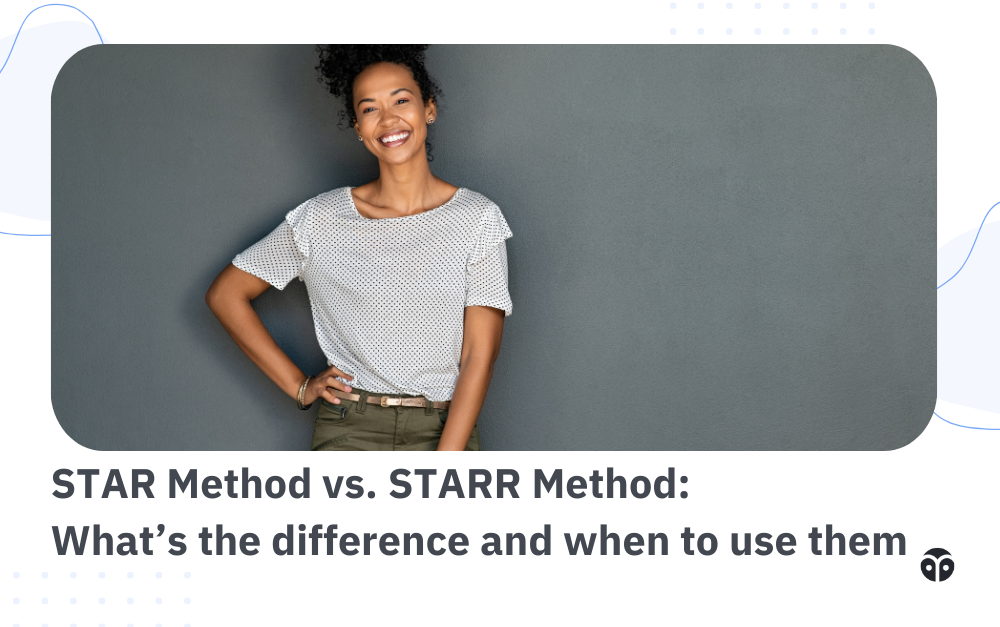STAR Method vs. STARR Method: What’s the difference and when to use them
Learn the difference between the STAR and STARR methods for behavioral interviews (and when to use each). While STAR helps structure answers with Situation, Task, Action, and Result, STARR adds Reflection to showcase personal growth.

Interviews are tough. It’s hard to come up with concise, thorough answers to questions on the fly, especially if you’re nervous or trying to make a great impression. That’s why having a structured approach to answering behavioral questions can be really beneficial.
Two popular methods for organizing your thoughts during interviews are the STAR method and the STARR method. While similar in many ways, the STARR method takes things a step further by helping you showcase not only what you’ve done but also what you’ve learned. Let’s break them down and figure out when to use each one.
What is the STAR method?
The STAR method is a framework designed to help you provide clear, structured answers to behavioral interview questions. It stands for:
- Situation: Set the scene. What was the context or problem you were dealing with?
- Task: What was your goal or responsibility in that situation?
- Action: What specific steps did you take to address the task or problem?
- Result: What was the outcome? How did your actions make a difference?
Using STAR ensures that your responses are direct, relevant, and easy for the interviewer to follow. It’s a great way to highlight your problem-solving skills and accomplishments without rambling or leaving out critical details.
What is the STARR method?
The STARR method builds on STAR by adding a fifth and final step: Reflection. This extra step allows you to go beyond simply describing what happened to show what you learned or how the experience shaped you. Here’s what each part of STARR looks like:
- Situation: Describe the specific situation or context. Give enough detail to help the interviewer understand the scenario.
- Task: Outline your goal or the challenge you faced. Focus on your responsibility in the situation.
- Action: Highlight the specific steps you took. Be as detailed as possible—mention tools, strategies, or teamwork.
- Result: Share the outcome. Whenever possible, back it up with metrics or concrete evidence.
- Reflection: Discuss what you learned. Did you discover a better way to approach similar situations? Develop a new skill? Gain insight into how you work best? This step shows self-awareness and a growth mindset.
For example, if you were asked to “tell me about a time you resolved a conflict on a team,” you might use the STARR method like this:
- Situation: A project deadline was approaching, but two team members couldn’t agree on a key element.
- Task: As the project lead, it was my responsibility to mediate and ensure we hit the deadline.
- Action: I organized a meeting to hear both sides, facilitated a brainstorming session for alternative solutions, and helped the team reach a compromise.
- Result: We delivered the project on time, and both team members felt their input had been valued.
- Reflection: I learned that clear communication and giving everyone a chance to be heard are critical to resolving conflicts quickly and maintaining morale.
Why add reflection?
The Reflection step is what sets the STARR method apart from STAR. It gives you an opportunity to demonstrate how you grow from your experiences. For roles that value continuous improvement—like engineering or product management—this step can make your answers stand out. It shows that you’re not just solving problems but learning from them, which is a highly desirable trait in any candidate.
When to use STAR vs. STARR
- Use STAR for straightforward behavioral questions where the focus is on actions and results. For example: “Tell me about a time you hit a challenging deadline.”
- Use STARR for questions where the interviewer might be probing for self-awareness, growth, or lessons learned. For example: “Tell me about a time you made a mistake at work and how you handled it.”
Quick tips for using the STARR method
To get the most out of the STARR method, keep these tips in mind:
Do’s:
- Take a moment to think about your answer before diving in.
- Use specific examples from your experience.
- Be concise while including all the key details.
- Use “I” statements to focus on your role in the situation.
- Include Reflection where it makes sense—what did you learn, and how have you applied it since?
Don’ts:
- Don’t rush into your answer without organizing your thoughts.
- Avoid hypothetical examples—stick to real experiences.
- Don’t assume the interviewer knows the context—be clear and specific.
- Avoid overly vague “we” statements that downplay your individual contributions.
How the STARR method helps you stand out
Interviews aren’t just about proving you can do the job—they’re about showing how you think, adapt, and grow. The STARR method helps you craft responses that are not only clear and structured but also thoughtful and memorable. Whether you’re prepping for your first engineering interview or aiming for a senior role, this approach can help you confidently highlight your skills and experiences.
By adding that final “Reflection” step, you elevate your answers from good to great, showing interviewers that you’re not just capable—you’re constantly evolving.
Get holistic interview prep with Formation
Despite the challenging economy, we've been able to help our Fellows land life-changing roles. Formation’s Mentors come from some of the best tech companies in the world, and the personalized career coaching and supportive community make for a great support system.
If you’re having trouble navigating your job search on your own, apply here and get unconditional support from a team of engineering mentors, technical recruiters, career coaches, and more.



